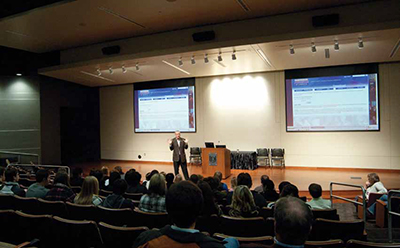While fiber optic cable is hardly new—it was first used commercially on a large scale in the telecommunication industry over three decades ago—it may still be a relatively unfamiliar technology for some AV integrators.
At Davenport University in Grand Rapids, MI, Crestron DM-CBL-NP-SP DigitalMedia cable and pre-terminated CRESFIBER-DUAL-SC connects all audio and video signals. With costs falling and implementation now as easy as category cable, is fiber destined to become the go-to network solution any time soon?
According to Justin Kennington, DigitalMedia product line manager for Crestron Electronics, the company is currently working on its third-generation fiber optic transport for its distribution, control, and management products. Scheduled for rollout in mid-2014, it will combine audio/video, control, and ethernet transport over one fiber with the capacity for up to 4K video resolution, and with much higher data rates than current products.
“The TV guys can print more transistors, which means they’ve got to get more pixels to the screen, and it’s the job of guys like me to make sure we have the bandwidth to support them in that,” he said. “Fiber is an inherently higher bandwidth platform than category cable. At some point we have to hit some limit where we just can’t cram any more bits down this inexpensively-made copper cable.”
While there is undoubtedly still a supply of dark fiber available countrywide—a legacy of the dot-com bubble—it may be of limited use for campus networks since it is typically on a statewide and even nationwide scale. That said, retrofits and new builds incorporating a fiber network should and likely will become more prevalent, Kennington believes, especially since it is not that expensive.
“What’s expensive is the time to install it, and the time and parts necessary to terminate it. So what that means is that if you are pulling one strand of fiber, it costs very little more to pull 20 or 50 strands of fiber,” he said.
Whether or not a fiber network is appropriate also depends on its application, noted JX Loeb, product marketing manager for RGB Spectrum. The company has just launched its first large fiber system.
For campus-wide deployments, fiber may well be the go-to solution in certain circumstances, agreed Loeb. “You can do SDI with EQ for a couple hundred meters—it goes further than HDBaseT, which is 100 to 150.” It is possible to extend Cat-6 transports, “But if you start needing HDCP compliance, and with the new higher resolutions we’re getting into, that gets complicated,” he added.
“The cost of fiber itself is decreasing while the cost of copper increases,” Loeb also noted.
Fiber has several advantages over copper, including inherent immunity to noise and interference, said Paul Hand, senior product manager for AMX . “Even something as simple as a lightning strike can cause damage inside of an environment on copper. Fiber is just going to be inherently less susceptible.”
Plus, said Hand, “There are some applications in which a copper solution just won’t work.” Fiber has a significant advantage where distance is a factor, for instance: “Ten kilometers is something that you would never see in the copper world.”
Some applications demand optical transmission, he continued. “Inside of some medical environments they absolutely require electrical isolation in between operator rooms. Similarly, in the government world, they have strict requirements for the ability to not tap in or electrically sniff an electrical path. You can’t do that unless you have an optical path,” which offers resistance to tampering.
Yet despite its advantages, fiber is not yet the default for new or retrofit network installations. “HDBaseT these days represents around 85 percent of our transport sales by quantity, and that leaves fiber at around 15 percent,” Kennington reported. “But we see a lot of opportunity for growth in fiber.”
Fiber is still generally a more expensive solution, he allowed. “Yet it can be easier to install in very large scale infrastructures, and that ease of installation can recoup some of the upfront cost of fiber.”
Some integrators balk at dealing with fiber, he continued, but new fiber and connector technologies mean that installation can be as easy, if not easier, than category cable. “I think it’s just fear of the unknown. It’s not hard once you learn it.”
If the application demands guaranteed service with immunity to outside influences then an all-fiber system is the way to go, said Hand. If someone is already pulling cable, it might as well be fiber. “It’s a little more costly up front, but ultimately, you have homogenous distribution system architecture from that point forward.”
But not every application requires an all-fiber approach, he said. For other applications, “There’s significant cost savings to moving to a category cable solution, or even a more traditional baseband HDMI or DVI on shorter runs, and move to an optical platform on significantly longer runs—in between buildings, or up and down floors.”
AMX accommodates those hybrid copper-fiber systems, said Hand. “Within the Enova DGX product platform you can have a category cable board right next to a fiber board on the input side or output side.” Those boards are hot-swappable and field upgradable, he added: “It doesn’t lock you into a single platform.”
Can integrators and installers make more money from campus-wide fiber network systems? “A fiber system can get well into six and seven figures, so certainly it’s a bigger job,” said Loeb. “But I think integrators have to be qualified, so bigger jobs equal bigger dangers. Some tertiary level guy who’s been doing ‘hang-and-bangs’ somehow lands a contract, he’ll lose his butt—unless he’s trained or has a staff with the experience to handle that.”
Knowledge is key, agreed Kennington. “If you can become the expert in fiber in your market—whether it’s your particular vertical, or your region, or whatever—then as end users start to see that building large-scale fiber plant is at least as cost-effective, if not more cost-effective, than building large-scale copper plant, then you can become the go-to integrator.”
Steve Harvey (sharvey.prosound@gmail.com) has been west coast editor for Pro Sound News since 2000 and also contributes to TVTechnology, Pro Audio Review, and other NewBay titles. He has over 30 years of hands-on experience with a wide range of audio production technologies.
What are the key considerations in implementing a campus-wide fiber network in a retrofit application?
Be sure the infrastructure is set up for expansion capability. The switcher capacity should be expandable without having to replace the units installed initially, and there should be enough fiber run to accommodate growth. Magenta Research has installed thousands of large matrix systems with hundreds of endpoints. With few exceptions, they all expand over time. Also, in the world of changing video standards, it is important to have a system that can be updated from any location on the video network. That saves a lot of golf-cart time.
—Andy Fliss, Director of Marketing, tvONE and Magenta
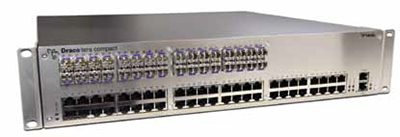
IHSE’s 80-port, 2RU Draco tera compact series switcher Since there is a great deal of multimode fiber installed today, it might be tempting to try to use that existing fiber for video transport applications. A word of warning to those who attempt it: multimode fiber can be very difficult to work with in digital video applications. Most video-link equipment is designed for use with single-mode fiber. While you can find video transmitters and receivers to use with multimode fiber, they are not widely available, and the link distances and data rates they support might not be sufficient for your application. Likewise, it’s also risky to use equipment designed for single-mode fiber with multimode fiber, or to attempt to connect the two types of fiber. The differences between them are simply too great. Any such attempts will most certainly be disappointing, as only a small fraction of the optical power will pass across the junction of the two fibers.
—Scott Bosen, Director of Marketing, Utah Scientific
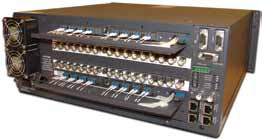
PESA routing switcher with fiber and BNC connections. When designing a fiber optic matrix, pay attention to the total loss sum, which may appear on a particular communications path, to make the transmitter’s output power appropriate to the receiver’s input sensitivity. Although most fiber optic component specifications are defined as worst case, matrix switchers and extender products with built-in diagnostics for fiber optic performance effectively provide close proximities to ensure proper light links for long distance connectivity over fiber optics.
—Chuck Tillett, President and COO, PESA
Pick the optimal fiber type that can handle the bandwidth required to distribute video. I would not advise using anything slower than a 10-gigabit ethernet (10GigE) backbone if it’s going to be a campus IPTV network. Otherwise, you can’t stream multiple channels of HD content reliably. Multimode optical fiber is only good to about 3,000 feet without repeaters, so single-mode fiber is the better choice. Use LC angle polish connectors for best performance.
—Clint Hoffman, Vice President of Marketing, Kramer
Rose Electronics understands that schools and universities often lack the resources necessary to update all of their IT equipment at once. Because of this, schools opt to upgrade only essential areas of their networking systems that will yield the most benefit. Rose Electronics fiber matrix switches and extenders enable utilization of legacy equipment using VGA, serial, analog audio, and PS/2 signals in conjunction with new HDMI, SDI, dual and single link DVI, and USB equipment. This provides full system integration across the campus and eliminates the need to replace the matrix switch as future upgrades are made to AV equipment.
—David Rahvar, General Partner, Rose Electronics
Pull 10 percent more fiber than you think that you will need. The cost to pull extra fiber strands is inconsequential to the “future proofing” of capacity on your network. Identify what types of signals are needed for transport and switching. Fiber extenders are typically type-specific and could require external converters for transport. Decide whether you require a point-to-point or point-to-multipoint network. Fiber is typically point-to-point, uncompressed transport, however, point to multipoint is possible using compressed signals over an ethernet network. Choose a closed network design if video is to be transported, as IT departments typically will not share the network for high bandwidth needs of HD video. Central switching with a “star topology” is an efficient audio/video/ data network design for point to point. If data only, a “self-healing” ring topology is possible.
—Don Hosmer, Regional Sales Manager, Opticomm/Emcore
Make sure your fiber is supported by your electronics. Single mode, multi-mode—is it a standard type (OM3, OM2, OM4, OS1, etc), and is it in good shape (low signal loss)? If there is a mix of fiber types, is your matrix capable of working with some or all types? Does the fiber go where you want it to?
—Justin Kennington, DigitalMedia Product Manager, Crestron
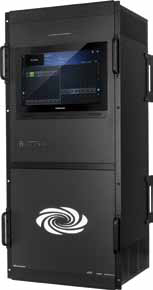
(Left) The Kalahari Resorts conference
center ballroom features a Crestron DM64x64; (Right) Crestron’s DM128x128 switcher.
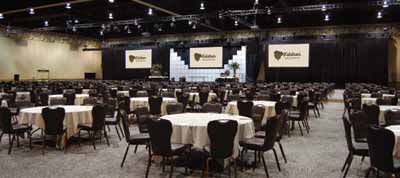
When using existing infrastructure to implement a campus-wide fiber network, there are a number of key considerations. Multimode fiber systems can usually be adapted for retrofit purposes, but existing single mode fiber can be difficult to integrate. Too many splices or patch bays in the system may negatively impact signal quality. The retrofitted network must also be able to support a range of signals (including composite, SDI, and HDCP-protected content), data types, pre-existing control systems, and emerging high-resolution signal formats.
—Jed Deame, Vice President of Marketing, RGB Spectrum
The first thing to make sure of is that the infrastructure chosen has enough data rate capability to support long-term data capabilities. The higher the overall data rate of an optical transport solution, the better positioned it will be to support higher data-rate signal style formats down the road. While much of this will be determined by the endpoint technology, attention needs to be given to the fiber infrastructure as well. Multimode versus single mode fiber will be a high level starting point and if multimode is selected, integrators will need to ensure the proper cable rating is provided. Within the overall fiber deployment, consideration should be given to the overall structure of the fiber distribution solution. Some applications will require a completely centralized solution that has “home runs” back to a single, very large distribution solution. This provides switching capability from any input to any or all connected outputs. Alternatively, system designs exist that combine a larger number of digital media switching solutions, which feed back to a centralized switch with trunk runs. This signal distribution architecture provides a lower overall cost, but requires some level of additional consideration for overall switching paths. Ultimately, a system designer is best served by standardizing on a single manufacturer.
—Paul Hand, Senior Product Manager, AMX
One problem businesses face when considering fiber optic matrix switch deployment is thinking that all equipment must be exclusively fiber and miles of installed copper must be discarded. Combining a fiber and copper infrastructure is a more practical method of installing new fiber optic matrix switchers. Looking for a matrix switch that can support both fiber and Cat-x serves as a much better solution than turning to a wholesale upgrade to a complete fiber-optic system.
—Chani Shah, Vice President of Sales and COO, IHSE USA
